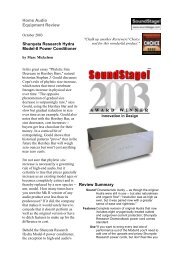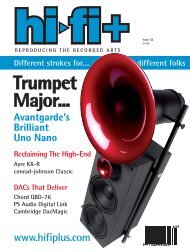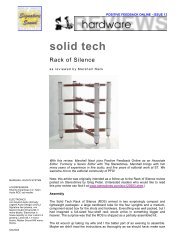Tangential Pivoted Tonearm
Tangential Pivoted Tonearm
Tangential Pivoted Tonearm
You also want an ePaper? Increase the reach of your titles
YUMPU automatically turns print PDFs into web optimized ePapers that Google loves.
<strong>Tangential</strong> <strong>Pivoted</strong> <strong>Tonearm</strong>
Basics<br />
Thales of Miletus belonged to the group of the Seven Sages of Greece.<br />
After later lore of the Hellenistic epoch we learn that he went in<br />
for many long journeys among to Egypt. There he should have measured<br />
the height of the pyramids by means of the length of the shades.<br />
It seems that he also brought more knowledge from Egypt as<br />
the discovery that the circumferential angle in the half circle is rectangular.<br />
According to this the half circle above of the hypotenuse is<br />
called Thales’ Circle.<br />
The only certain date of his life seems to be May 28th 585 B.C.; this<br />
is the date for which Thales predicted a solar eclipse. This occurrence<br />
was certified by astronomer retrospectively.<br />
3
Philosophy<br />
It all began when Micha Huber sought for a way to combine the advantages<br />
of a conventional tonearm and those of a linear tangential<br />
pick-up arm. The solution method is based on the well-known elementary<br />
school aid to construct a tangent: the Thales’ Circle.<br />
After much thought, endless sketches and calculations, a threedimensional<br />
mechanical solution emerged that satisfies all the requirements<br />
placed on a modern pick-up system – provided the mechanics<br />
functions as precisely and reliably as a Swiss watch.<br />
The long-cherished dream of geometrically correct sensing with low<br />
friction pivot bearings became reality. A new patent was added to<br />
the dozens of existing patents that testify to this dream: CH694567<br />
– <strong>Tangential</strong> <strong>Pivoted</strong> <strong>Tonearm</strong>, announced in May 2004.<br />
Micha Huber was trained both as a mechanical engineer and a professional<br />
musician. After working five years in the field of developing<br />
finest Swiss watches he launched his own company: HiFiction AG.<br />
Within this company his dream of combining music and mechanics,<br />
culture and precision, became reality.<br />
5
Inspiration<br />
Music<br />
evokes a moving emotional response. Technology in its proximity to<br />
art is able to touch, and even to inspire – especially if it is put in the<br />
service of music. Thales combines both music and technology in a<br />
unique way.<br />
Innovation<br />
is known by new and progressive solutions for specific problems –<br />
even for problems considered as unsolvable. Thales is the only tangential<br />
pivoted tonearm.<br />
Precision<br />
ensures the closest approach of a technical device to the perfect intellectual<br />
idea. The high precision of the construction of the pivoted<br />
tonearm Thales makes the ideal of the tangential tracking on the<br />
Thales’ Circle become reality.<br />
7
Benefit<br />
The Thales tonearm creates a bond between music and technology<br />
in a very unique manner. It combines an elegant theoretical solution<br />
with uncompromising technical realization. The manufacturing of its<br />
more than 100 parts is done with the most modern process engineering<br />
in Switzerland. Our watchmakers fabricate and assemble the<br />
micromechanical parts. Twelve jewel bearings reduce the friction to<br />
the utmost. The materials used are carefully selected and tested.<br />
The benefit in detail:<br />
▪ no tracking error and no consequential resulting distortions<br />
▪ minimal friction because of pivot bearings; no linear bearings; no<br />
active tracking<br />
▪ short tonearm with little resonance<br />
▪ symmetric inertia at the tracking point in all axles<br />
▪ damping and compensation of the skating force through weights<br />
9
Solutions out of a Century<br />
To reduce or minimize the falsification of the scanning, a lot of different<br />
solutions have been chosen since the invention of the phonograph<br />
in 1887. The first patent of a tangential installation in 1923<br />
shows still the most spread method of resolution. The pick-up is linearly<br />
guided, exactly as the cutting of the masters. You can find<br />
active (driven by a motor) or passive (smoothly running) systems.<br />
The drawbacks of the linear principle can be considered the extraordinary<br />
technical charges to minimise the friction or the continuous<br />
correction of the carriage, because of the angular deviation. Often<br />
this asks for many different units and sensitive constructions.<br />
The only non-linear solution that was produced in series is the famous<br />
Garrard Zero-100. A parallelogram construction with its pivot<br />
bearing, which is changing the crank angle of the Headshell<br />
constantly and reduces the tracking error to 0.43°. We find resembling<br />
methods of resolution at Burne-Jones and others, mostly<br />
two armed constructions. By regarding from the mathematical and<br />
geometrical perspective we realise that the tracking error has been<br />
minimised but not kept back completely. In this way we can’t speak<br />
from a tangential scanning but rather from a improvement of the<br />
tonearm geometry in consequence of the ingenious correction of the<br />
crank angle.<br />
11
Technology<br />
As the name presents, the Thales tonearm is based upon the tangential<br />
scanning from the movement and the adjustment on the<br />
Thales circle: All the triangles ABC on the Thales circle around M are<br />
standing right-angled. Like this BC is always rectangular to AC and<br />
so in every position tangential to the record channel with actual radius<br />
AC. By setting up the pick-up exactly under the position C and<br />
in the alignment of straight BC results – at variable length of BC- a<br />
tangential scanning. This construction is patented since March 31st<br />
2005 under the number CH694567.<br />
Although the scanning of the Thales’ Circle seems at first glance obviously<br />
and simple, it demands the attention of different details. All<br />
the measures are located in the milligram range so that the arm<br />
won’t produce lateral forces and that the seating remains constantly.<br />
The cardan bearings are constructed vibration-less and compact.<br />
Precise sapphire bearing make sure that there is also low friction<br />
next to the pivot of the adjustment-arm. The pivot bearing above<br />
the head is made out of 25 individual parts. The whole construction<br />
is manufactured with highest precision what guarantees a smoothrunning<br />
and free of play between the Headshell and the tonearm.<br />
13
Thales original<br />
This is the original. The Thales combines traditional craftsmanship<br />
with the most up-to-date technology. The cardanic bearings are<br />
gold-plated while the pure magnesium arms show their natural colour.<br />
The head-shell and the cardanic bearings are treated with a<br />
unique handmade scratch-finish – a secret method of our goldsmith.<br />
All edges are carefully polished to show the relationship to<br />
finest Swiss watches. Each tonearm is engraved by hand.<br />
Features:<br />
▪ finest sapphire bearing, twelve jewels<br />
▪ gold-plated cardanic bearings, handmade finish "scratched"<br />
▪ magnesium arms, handmade finish<br />
▪ magnesium headshell, handmade finish "scratched"<br />
▪ effective length: 6/11 inches<br />
▪ effective tonearm mass: 12g<br />
15
Thales AV<br />
This tonearm shows Swiss precision. Thales AV stands for Aluminium<br />
Version because the arms are made of a special aluminium alloy.<br />
The bronze anodized finish of these arms guarantiees a unique<br />
look and provides high corrosion-resistance. The cardanic bearings<br />
are hard chrome-plated to point out the impression of a highprecision-instrument.<br />
Features:<br />
▪ finest sapphire bearing, twelve jewels<br />
▪ hard-chrome plated cardanic bearings<br />
▪ aluminium arms, bronze anodized finish<br />
▪ aluminium headshell, bronze anodized finish<br />
▪ effective length: 6/11 inches<br />
▪ effective tonearm mass: 16g<br />
17
Simplicity<br />
The Simplicity is the little fellow of the Thales tonearm. Its geometry<br />
is based on a newly created tetragon solution which reduces the tracking<br />
error to a maximum of 0.008°. It uses the same bearing technology<br />
as the Thales tonearm. Six jewels and four subminiature ball<br />
bearings make sure that the friction and clearance are within our<br />
state-of-the-art tolerances. The intrinsic frequencies of the two tonearm<br />
tubes are carefully tuned up in inharmonic proportions to<br />
even top the damping properties of any single-arm design.<br />
The Simplicity comes with a special tool to make sure the installation<br />
is as precise as the manufacturing. The headshell can be taken<br />
apart easily for exact placing of the cartridge. The surfaces of the<br />
tubes are bronze anodized, using 0.1g of a specific salt per litre<br />
electrolyte. All side forces are balanced by two little magnets.<br />
Features:<br />
▪ finest ruby bearing, six jewels<br />
▪ hard-chrome plated cardanic bearings<br />
▪ aluminium arms, bronze anodized finish<br />
▪ aluminium headshell, bronze anodized<br />
▪ effective length: 9 inches<br />
▪ effective tonearm mass: 19g<br />
19
Contact<br />
HiFiction AG<br />
Micha Huber<br />
St. Gallerstrasse 20<br />
CH-8352 Elsau<br />
+41 52 202 43 12<br />
info@tonarm.ch<br />
www.tonarm.ch<br />
Your dealer:<br />
Made in Switzerland by<br />
20


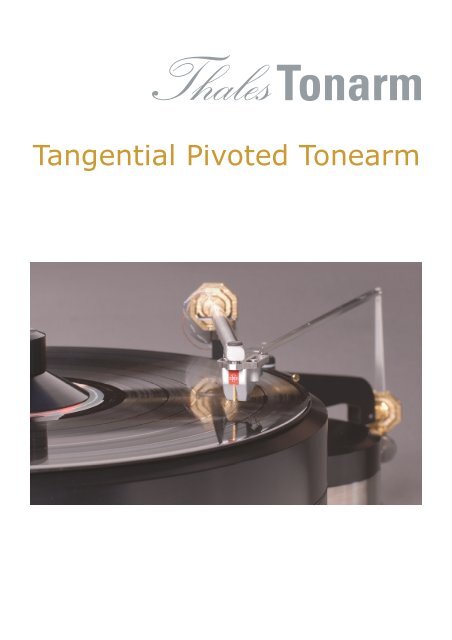
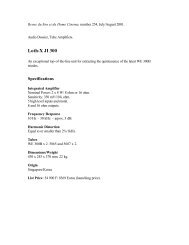

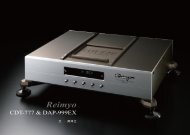

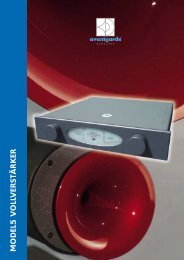
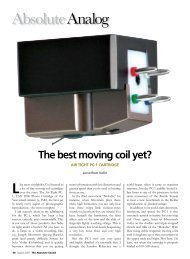
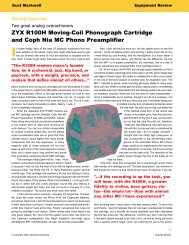
![DAP-999 EX Limited [pdf] - Audio Note Singapore](https://img.yumpu.com/27191044/1/190x253/dap-999-ex-limited-pdf-audio-note-singapore.jpg?quality=85)
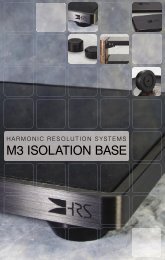
![Harmonix CS-120 Improved-Version [pdf]](https://img.yumpu.com/24411255/1/184x260/harmonix-cs-120-improved-version-pdf.jpg?quality=85)
